Historical Structures of the Temple Garden of Philosophy
Jikū kō Hill of Time and Space
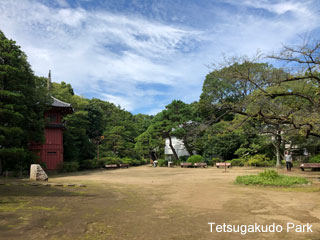 The Hill of Time and Space is located in the center of the Temple Garden of Philosophy. Here the park introduces masters of the study of philosophy through the Four Sages Hall, which honors Western and Eastern philosophers who transcend time, country, and region. Also, there is the Pagoda of the Six Wise Ones, which honors wise men of the East, and the Three Erudites Arbor, which honors Japanese scholarship.
The Hill of Time and Space is located in the center of the Temple Garden of Philosophy. Here the park introduces masters of the study of philosophy through the Four Sages Hall, which honors Western and Eastern philosophers who transcend time, country, and region. Also, there is the Pagoda of the Six Wise Ones, which honors wise men of the East, and the Three Erudites Arbor, which honors Japanese scholarship.
Additionally, near the end of seventy-seven features of the walking route are: the Cosmos Hall, which is a lecture hall that provides a space for applied philosophy; the Citadel of the Absolute, which provides a reading room in its library; and, the Inexhaustible Treasury, a museum that displays a collection of items from INOUE Enryo’s travels around Japan and the world over thirty years. When standing in the middle of the Hill of Time and Space, you can see all of the important historical structures of the Temple of Philosophy.
Tetsuri mon Gate of Philosophical Reason (Erected 1911–1914)
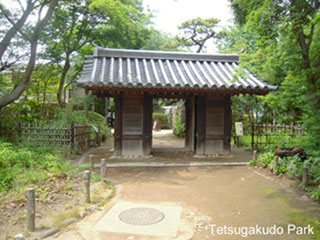 The Gate of Philosophical Reason is the central gateway to the world of philosophy. “Philosophical Reason” refers to the profound ways that comprise the essence of humanity and the world—the study of which being known as philosophy. In philosophy, there are two modes of thought: a worldview based on matter (materialism) and a worldview based on mind (idealism), and within those modes, too, there are mysterious examples of “supra-rational reasoning” that cannot be explained through regular logic. Enryo took the exploration of those mysteries as his starting point for philosophy.
The Gate of Philosophical Reason is the central gateway to the world of philosophy. “Philosophical Reason” refers to the profound ways that comprise the essence of humanity and the world—the study of which being known as philosophy. In philosophy, there are two modes of thought: a worldview based on matter (materialism) and a worldview based on mind (idealism), and within those modes, too, there are mysterious examples of “supra-rational reasoning” that cannot be explained through regular logic. Enryo took the exploration of those mysteries as his starting point for philosophy.
Placed on either side of the gate are two wooden statues, a yūrei ghost that represents the mysteries of the world of the heart and a tengu heavenly sentinel that represents the mysteries of the world of matter. The Gate is also referred to as the “Yōkai mon” Mythical Creature Gate.
Shisei dō Four Sages Hall (Built April, 1904)
Single-story square wooden design, pantile roof, single-layer construction
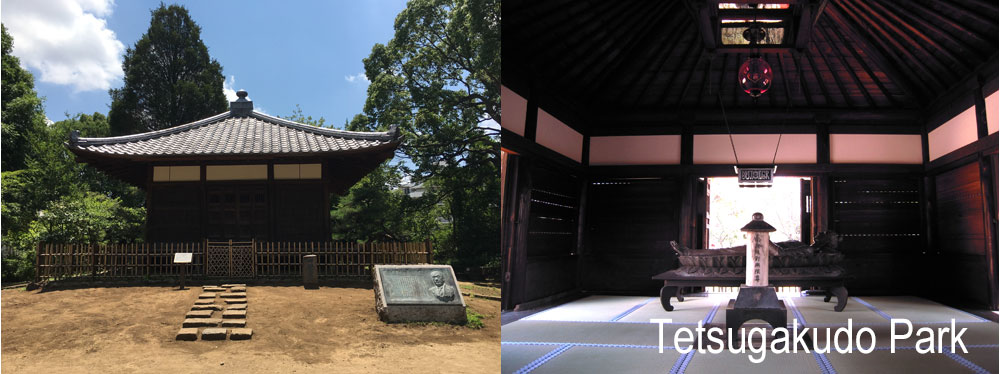
Honored in the Four Sages Hall are the four sage philosophers that most influenced INOUE Enryo: Confucius of Eastern philosophy, Shakyamuni Buddha, Socrates of ancient Western philosophy, and Kant of early modern Western philosophy. Originally the hall was called the Tetsugakudō (Philosophy Temple), highlighting the origin of the park’s name.
In the center of the ceiling there are four decorative plaques facing each wall that are inscribed with the names of the sages. These signify a prayer for the future development of philosophy, and this shows visitors the intentions of the founder INOUE Enryo.
The building features a four-walled square design, housing the Shōnen tō Recitation Stūpa stone pillar etched with the kanji characters “namu zettai mugen son” (reverence to the ultimate infinite honorable), indicating that philosophy means to enjoy devoting one’s life to investigating the truths of the universe.
The kyūtō circular lamp hanging from the ceiling represents the heart—i.e. the mind—and the kōro censer (incense burner) underneath it represents matter—i.e. materialistic desires—representing the idea that even though the heart is sullied by soot rising from those desires, if we keep building on our efforts to better ourselves we will not lose the purity of our heart.
The supine Buddha-entering-Nirvana statue (crafted by WADA Kaheiji) located on the far side of the Shōnen tō was commissioned by Enryo’s son Gen’ichi as an offering to the spirit of his friend who died in war. There had been a plan to enshrine it in a hall to be built in what is now the azalea garden, but as that did not eventuate it was placed in the Four Sages Hall in 1940.
Rokken dai Pagoda of the Six Wise Ones (Built November, 1909)
Wooden six-sided pagoda, two-story outer facade, three interior stories, one and two layer construction, pantile roof, wooden board-finished exterior
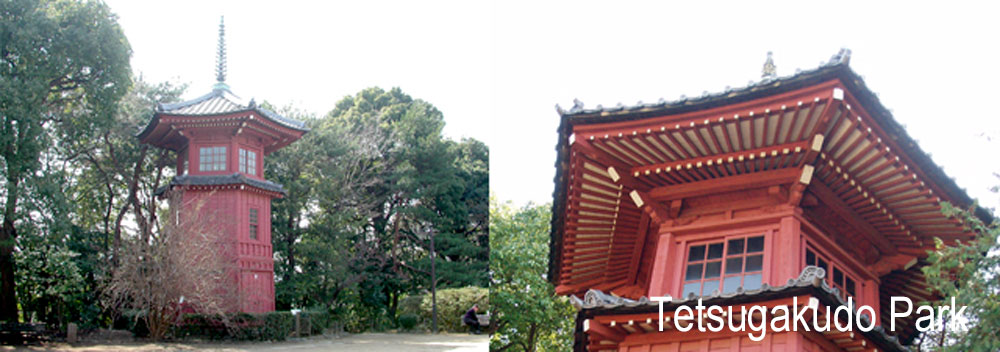
This vermillion-lacquered three story six-sided structure acts as a symbol of the Temple Garden of Philosophy. The pagoda pays homage to six wise men from Asia: from China, Zhuāngzǐ as a representative of Daoism and Zhū Xī the founder of the Zhu Xi school of Neo-Confucianism; from India, Nāgārjuna who systematized Buddhism and Kapila who was the founder of Brahmanic number theory philosophy; and, from Japan, Shōtoku Taishi who contributed to the spread of Buddhism and Sugawara no Michizane who was a medieval period intellectual.
In the past, there were framed pictures bearing images of the six wise men hanging from the six edges of the top-story roof, and in the center of these hung a small bell engraved with each of the six names but now the images are displayed in the Mujin zō Inexhaustible Treasury. Additionally, the pagoda is decorated with items (such as stone implements and earthenware) collected by INOUE Enryo from around Japan and the world and with more than several hundred types of mamori fuda paper talismans from temples and shrines. (Currently, photographs are being displayed.)
Further, on the center of the roof is a nine hōrin dharma ring-adorned sōrin finial that is topped with a hōju precious orb, and along one edge of the roofing tiles—connected to there being tengu matsu pine trees growing nearby—there are tengu heavenly sentinel tiles for warding off fire.
Mujin zō Inexhaustible Treasury (Estimated built circa 1909–1912)
Two-story design, hipped tile roof
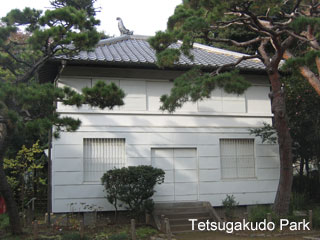 The Inexhaustible Treasury is a building that functions as a museum and displays items from around the world collected by INOUE Enryo from his three international journeys over twenty-two years and his 5,291 Japan-wide travelling lectures to as many as 1.3 million people over thirty years. The first story is named the Banshō ko Treasury of the Universe and the second story, Kōjō rō Progress Tower.
The Inexhaustible Treasury is a building that functions as a museum and displays items from around the world collected by INOUE Enryo from his three international journeys over twenty-two years and his 5,291 Japan-wide travelling lectures to as many as 1.3 million people over thirty years. The first story is named the Banshō ko Treasury of the Universe and the second story, Kōjō rō Progress Tower.
Currently, images of the Six Wise Ones and a portion of the collection is stored and displayed here, but most of it is stored and displayed in the Yamazaki Memorial Nakano Historical Museum and the Toyo University Inoue Enryo Memorial Museum.
For a time, INOUE Enryo’s study was located on the second story, and he carried out his research activities there.
Uchū kan Cosmos Hall (Built October, 1913)
Single-story square wooden design, pantile roof, two layer construction, gabled porch at corner
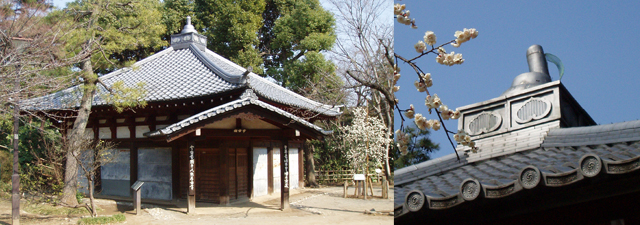
Enryo saw philosophy as the scholarly pursuit of researching the truths of the universe, and he built this Cosmos Hall as a lecture room for holding philosophical talks and classes. Inside, there is a sideways-oriented eight tatami mat room called the Kōkoku den Imperial Chamber which is designed to represent Japan’s place in the world. Here, philosophy is understood as the exploration of social and national principles, and Japan is held as the most beautiful country in the world. In 1916, Sunday lectures and summer workshops were held, meaning that the Hall found its functional beginnings as a place for the practical realization of Inoue Enryo’s social education.
Further, placed in the center is a statue of a standing Shōtoku Taishi (crafted by WADA Kaheiji). This, along with the Buddha-entering-Nirvana statue in the Four Sages Hall, was installed in 1940 by Enryo’s son Gen’ichi, with the original plan being to place it in a building to be erected in what is now the azalea garden, but with the war affecting plans it was instead placed in the Imperial Chamber.
Zettai jō Citadel of the Absolute (Built October, 1915)
Two-story wooden design, hipped (/stooped) roof with additional monitor roof, pantile with some iron plate tiles, two layer construction, iron plated exterior walls, flat roof bungalow vestibule, iron plate tiles
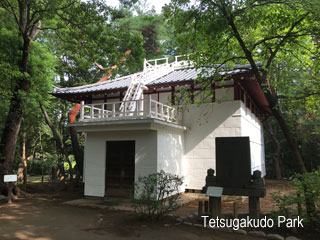 Pointing to the idea that the millions of books in existence make up the myriad constituents of philosophy and the principle that if we manage to read all of them we will arrive at the “absolute wonderful state,” this building, which functions as a library, was given the name Citadel of the Absolute.
Pointing to the idea that the millions of books in existence make up the myriad constituents of philosophy and the principle that if we manage to read all of them we will arrive at the “absolute wonderful state,” this building, which functions as a library, was given the name Citadel of the Absolute.
In the beginning, it was established as a library making works—particularly those from Enryo’s own collection—available to the public, and the first story housed Japanese and Chinese works in the right-hand bookshelf and Buddhist works in the left-hand side, but today the works are stored elsewhere so it no longer serves its original role as a library.
On the second story, there is a reading room called Kannen kyaku Concept Leg, which is a space with a relaxed atmosphere where the tatami mats are positioned to receive light from the skylight. There is also a reading room exclusively for women. On the rooftop, there is an observation (/viewing) deck for relaxing after reading. In the past, people could view Mount Fuji off in the distance from there, but at present it is closed to the public.
Sangaku tei Three Erudites Arbor (Estimated built circa 1909–1912)
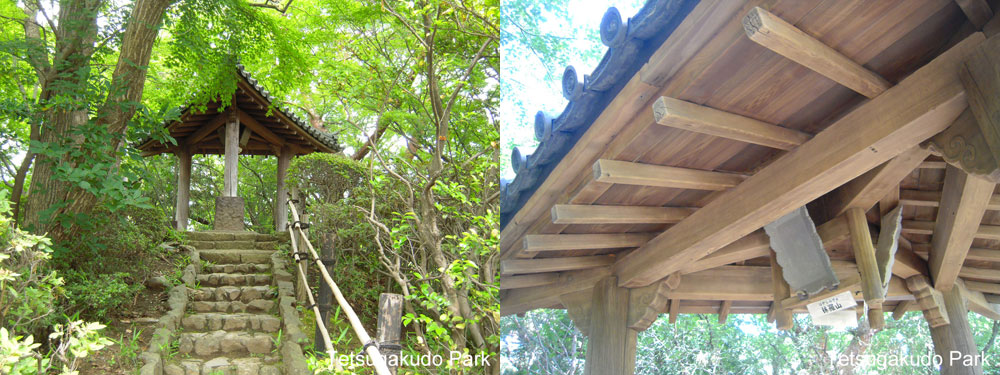
The Three Erudites Arbor is a structure that pays homage to the erudite scholarship of three of the most prolific representatives of Japan’s time-honored traditions of Shinto, Confucianism, and Buddhism: respectively, HIRATA Atsutane, HAYASHI Razan, and Shaku Gyōnen.
The name Sangaku tei plays on the words “sangaku” (three scholars) and “sankaku” (three-sided) which sound similar, and the design of this small arbor/gazebo features a triangular pyramid-shaped roof supported by three pillars, located at the top of a triangular pyramid-shaped artificial hill. Stone plaques depicting images of the three erudite scholars adorn the three faces of the ceiling, and previously in the middle a triangular pyramid-shaped object inscribed with kanji characters representing Shinto, Confucianism, and Buddhism used to hang down, but now this is displayed in the Inexhaustible Treasury.
Others
Jōshiki mon Gate of Common Sense, **Dokuro an Hut of the Skull Hermitage/Kishin kutsu Hollow of Gods and Spirits, En’eki kan View of Deduction, Azumaya square gazebo
** Hut of the Skull Hermitage/Hollow of Gods and Spirits are used as the Reimei kaku Loft of Spiritual Light (assembly space).
